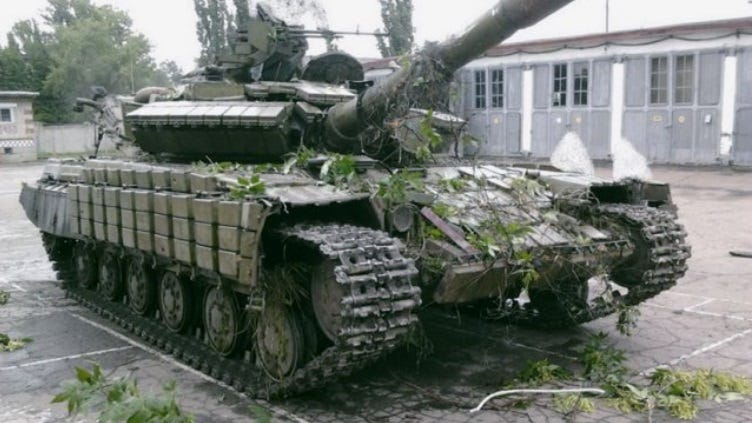Cold War Super-Tanks Enter Battle in Ukraine
T-64s waited five decades for major combat
The Soviet T-64 tank is a Cold War oddity. Designed by the Kharkov Tank Factory in Ukraine, the 40-ton armored vehicle represented a huge technological leap ahead of existing T-55 and T-62 tanks when it entered service in the mid-1960s.
But the advanced T-64 would see merely sporadic combat in Russia’s border wars. Only today, 50 years after it first appeared, is the vehicle playing a leading role in a serious conflict—in Ukraine, where both the government in Kiev and Russian-backed eastern separatists have deployed T-64s in vicious urban fighting.
The T-64 introduced a number of advancements, including a new diesel engine. It also replaces the human loader with an automatic device for ramming shells into the breech, reducing the overall crew to just three people and saving weight. The T-64 was the first Soviet tanks with the now-standard 125-millimeter smooth-bore cannon, which in upgraded T-64Bs can fire a guided missile through its tube.
The Soviets never exported the T-64, preferring to sell cheaper, simpler T-55s, T-62s and T-72s. Throughout the later decades of the Cold War, thousands of T-64s equipped Soviet armies, primed to wage apocalyptic tank war with American M-1s, German Leopards and British Challengers.
The T-64 was more than adequate to the task. “This particular tank was provided with certain capabilities that were more advanced than NATO tanks that would not appear for an additional 15 or 16 years,” U.S. Army Maj. James Warford concluded in a 1992 thesis.
When the Soviet Union broke up, Ukraine inherited hundreds of T-64s …and the factory that built the tanks. Recently enhanced with new armor and a so-called “active defense” system than shoots projectiles in order to intercept incoming rockets, the rebuilt T-64BM Bulat is Ukraine’s most advanced tank.
When eastern separatists—armed, supplied and reinforced by Russian agents—rose up this spring, demanding to split away from Kiev and join Moscow, Ukraine sent T-64s into combat.
 And thanks to Russia, so did at least one rebel group. On June 14, NATOpublished satellite imagery supposedly showing unmarked T-64s crossing from Russia into Ukraine. Six days later, Twitter user @mstyslav9 posted a photo they claimed depicted a T-64 belonging to the Donetsk People’s Republic separatist army.
And thanks to Russia, so did at least one rebel group. On June 14, NATOpublished satellite imagery supposedly showing unmarked T-64s crossing from Russia into Ukraine. Six days later, Twitter user @mstyslav9 posted a photo they claimed depicted a T-64 belonging to the Donetsk People’s Republic separatist army.
It’s possible Moscow sent T-64s because it could then convincingly argue that the rebels had gotten the tanks from Kiev’s armories, rather than from Russia.
To clarify that the T-64s are not stolen Ukrainian examples, on June 29 the Ukrainian government showed off a captured rebel T-64. “T-64BV under this serial number was issued in October 1987 at the Kharkov Tank Factory and sent to a military unit, which at that time [was] stationed in Russia,” Kiev asserted, according to Jane’s.
Captured rebel T-64. Ukrainian government photo
The Ukrainian government added that it had traced newly-built components on the tank to a factory in Saint Petersburg, Russia.
Jane’s concluded in late June that the rebels possessed at least three, and as many as “double figures” T-64s—but cautioned against alarm. “The presence of [main battle tanks] operating in rebel hands is undoubtedly a highly unwelcome development for the Ukrainian military, however their practical utility may be limited.”
“Unless supported by combined arms forces, MBTs can prove highly vulnerable to attack from air power, infantry armed with anti-tank guided weapons and other MBTs,” Jane’s stated. “Additionally, they require a significant supply chain to maintain in the field.”
In light of tanks’ huge appetite for fuel, parts and repairs, it makes sense that Russia would supply T-64s to its rebel proxies instead of other tank models. The T-64 is, more than anything else, a Ukrainian tank—having been manufactured in that country. Rebels shouldn’t have too much trouble finding local people who can help maintain the vehicles.
And the tanks’ vulnerability cuts both ways. On July 1, Ukraine called off a 10-day ceasefire and renewed its attack on rebels in Donetsk and other eastern cities. After a day of intensive fighting, the government admitted that rebels had managed to put a Ukrainian army T-64 “out of action.”
David Axe’s new book Shadow Wars is out. Sign up for a daily War is Boring email update here. Subscribe to WIB’s RSS feed here and follow the main pagehere.
No comments:
Post a Comment